Advanced Financial Accounting Report: IFRS, Asset Valuation & Theories
VerifiedAdded on 2021/06/15
|9
|2232
|14
Report
AI Summary
This report on Advanced Financial Accounting analyzes the qualitative characteristics of financial statements under IFRS, highlighting issues of understandability, comparability, and faithful representation. It examines the impact of these characteristics on investors and the challenges posed by IFRS complexity. The report then explores the Australian government's decision regarding the Corporations Act through the lens of public interest, capture, and economic interest group theories of regulation. Finally, it assesses the implications of US companies' asset revaluation practices under FASB Statement No. 144, discussing the motivations for asset revaluation, its impact on book value and shareholder wealth, and the role of directors. The report provides a comprehensive overview of financial accounting principles and their practical applications.

Running head: ADVANCED FINANCIAL ACCOUNTING
Advanced Financial Accounting
Name of the Student
Name of the University
Author’s Note
Advanced Financial Accounting
Name of the Student
Name of the University
Author’s Note
Paraphrase This Document
Need a fresh take? Get an instant paraphrase of this document with our AI Paraphraser
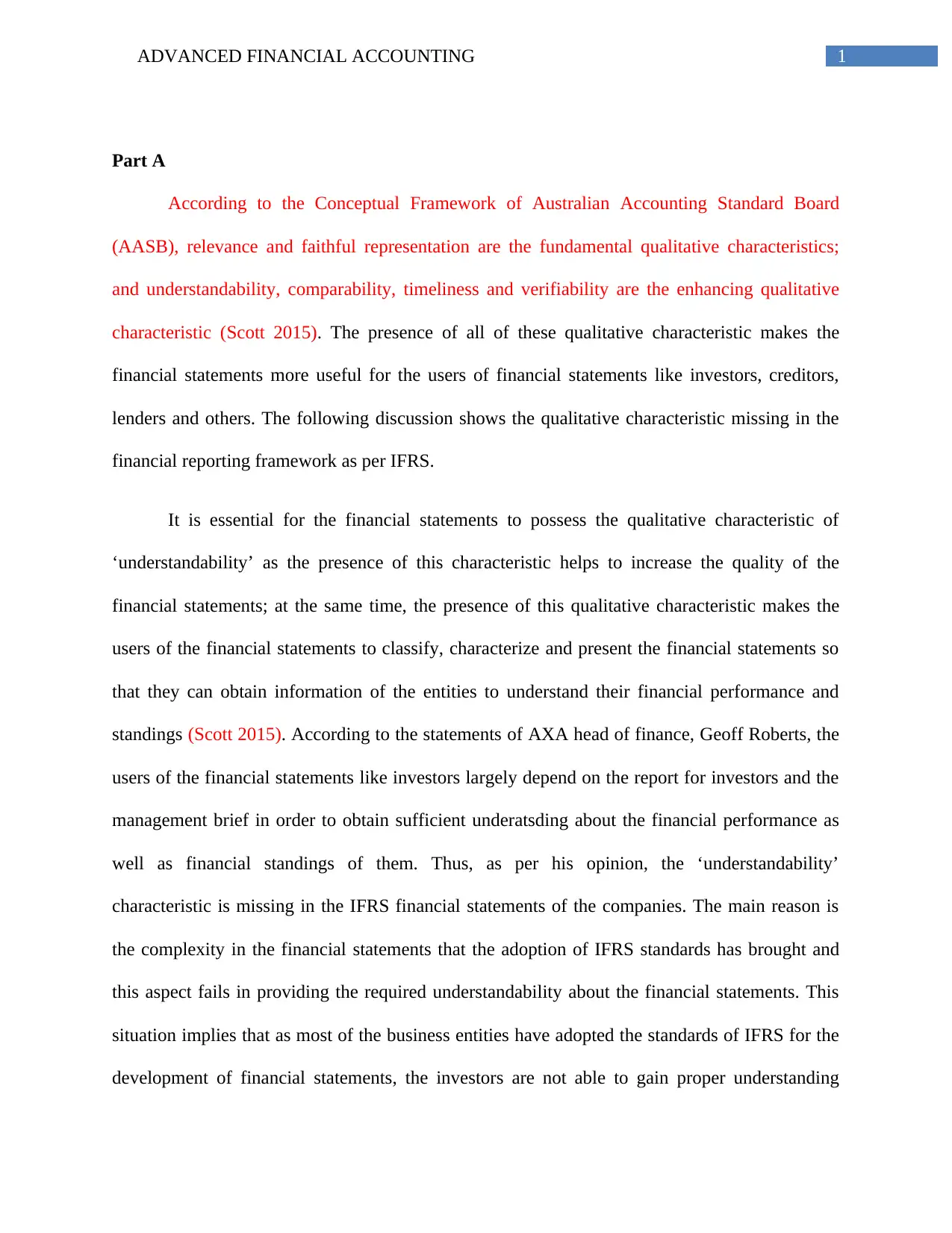
1ADVANCED FINANCIAL ACCOUNTING
Part A
According to the Conceptual Framework of Australian Accounting Standard Board
(AASB), relevance and faithful representation are the fundamental qualitative characteristics;
and understandability, comparability, timeliness and verifiability are the enhancing qualitative
characteristic (Scott 2015). The presence of all of these qualitative characteristic makes the
financial statements more useful for the users of financial statements like investors, creditors,
lenders and others. The following discussion shows the qualitative characteristic missing in the
financial reporting framework as per IFRS.
It is essential for the financial statements to possess the qualitative characteristic of
‘understandability’ as the presence of this characteristic helps to increase the quality of the
financial statements; at the same time, the presence of this qualitative characteristic makes the
users of the financial statements to classify, characterize and present the financial statements so
that they can obtain information of the entities to understand their financial performance and
standings (Scott 2015). According to the statements of AXA head of finance, Geoff Roberts, the
users of the financial statements like investors largely depend on the report for investors and the
management brief in order to obtain sufficient underatsding about the financial performance as
well as financial standings of them. Thus, as per his opinion, the ‘understandability’
characteristic is missing in the IFRS financial statements of the companies. The main reason is
the complexity in the financial statements that the adoption of IFRS standards has brought and
this aspect fails in providing the required understandability about the financial statements. This
situation implies that as most of the business entities have adopted the standards of IFRS for the
development of financial statements, the investors are not able to gain proper understanding
Part A
According to the Conceptual Framework of Australian Accounting Standard Board
(AASB), relevance and faithful representation are the fundamental qualitative characteristics;
and understandability, comparability, timeliness and verifiability are the enhancing qualitative
characteristic (Scott 2015). The presence of all of these qualitative characteristic makes the
financial statements more useful for the users of financial statements like investors, creditors,
lenders and others. The following discussion shows the qualitative characteristic missing in the
financial reporting framework as per IFRS.
It is essential for the financial statements to possess the qualitative characteristic of
‘understandability’ as the presence of this characteristic helps to increase the quality of the
financial statements; at the same time, the presence of this qualitative characteristic makes the
users of the financial statements to classify, characterize and present the financial statements so
that they can obtain information of the entities to understand their financial performance and
standings (Scott 2015). According to the statements of AXA head of finance, Geoff Roberts, the
users of the financial statements like investors largely depend on the report for investors and the
management brief in order to obtain sufficient underatsding about the financial performance as
well as financial standings of them. Thus, as per his opinion, the ‘understandability’
characteristic is missing in the IFRS financial statements of the companies. The main reason is
the complexity in the financial statements that the adoption of IFRS standards has brought and
this aspect fails in providing the required understandability about the financial statements. This
situation implies that as most of the business entities have adopted the standards of IFRS for the
development of financial statements, the investors are not able to gain proper understanding

2ADVANCED FINANCIAL ACCOUNTING
about the financial performance and situation from investors report and management brief (Scott
2015).
Apart from understandability, it is essential for the financial statements to possess the
qualitative characteristic of comparability that is one of the enhancing qualitative characteristic.
The users of the financial statements of the companies can identify the similarities and
differences in the major financial substances of the entities in the presence of this qualitative
characteristic (Hoyle, Schaefer and Doupnik 2015). Terry Brown, the finance director of
Wesfarmers, talks about the difficulty for the analysts to analyse the notes to the financial
statements of IFRS as they can misinterpret if there is lack of technical knowledge. This situation
implies that the users of the financial statements need to have effective technical knowledge in
accounting in order to correctly interpret the notes to the financial statements as pet IFRS. Thus,
the IFRS financial statements and notes lack both understandability and comparability.
One of the most important qualitative characteristic of financial statements is faithful
representation of the financial information. This is a major fundamental qualitative characteristic
that ensures the compliance of the financial statements with the required accounting standards
and principles (Hoyle, Schaefer and Doupnik 2015). According to the statement of chief
financial officer of Commonwealth Bank, David Craig, the financial statements developed as per
the standards of IFRS fails to provide the true picture of the financial position of the companies
and this is one reason why the investors do not pay attention to these statements for gaining
financial information. It shows the absence of the qualitative characteristic of faithful
representation as the absence of compliances fails to provide information about the financial
position of the companies. Apart from this, the absence of this characteristic indicates towards
about the financial performance and situation from investors report and management brief (Scott
2015).
Apart from understandability, it is essential for the financial statements to possess the
qualitative characteristic of comparability that is one of the enhancing qualitative characteristic.
The users of the financial statements of the companies can identify the similarities and
differences in the major financial substances of the entities in the presence of this qualitative
characteristic (Hoyle, Schaefer and Doupnik 2015). Terry Brown, the finance director of
Wesfarmers, talks about the difficulty for the analysts to analyse the notes to the financial
statements of IFRS as they can misinterpret if there is lack of technical knowledge. This situation
implies that the users of the financial statements need to have effective technical knowledge in
accounting in order to correctly interpret the notes to the financial statements as pet IFRS. Thus,
the IFRS financial statements and notes lack both understandability and comparability.
One of the most important qualitative characteristic of financial statements is faithful
representation of the financial information. This is a major fundamental qualitative characteristic
that ensures the compliance of the financial statements with the required accounting standards
and principles (Hoyle, Schaefer and Doupnik 2015). According to the statement of chief
financial officer of Commonwealth Bank, David Craig, the financial statements developed as per
the standards of IFRS fails to provide the true picture of the financial position of the companies
and this is one reason why the investors do not pay attention to these statements for gaining
financial information. It shows the absence of the qualitative characteristic of faithful
representation as the absence of compliances fails to provide information about the financial
position of the companies. Apart from this, the absence of this characteristic indicates towards
⊘ This is a preview!⊘
Do you want full access?
Subscribe today to unlock all pages.

Trusted by 1+ million students worldwide
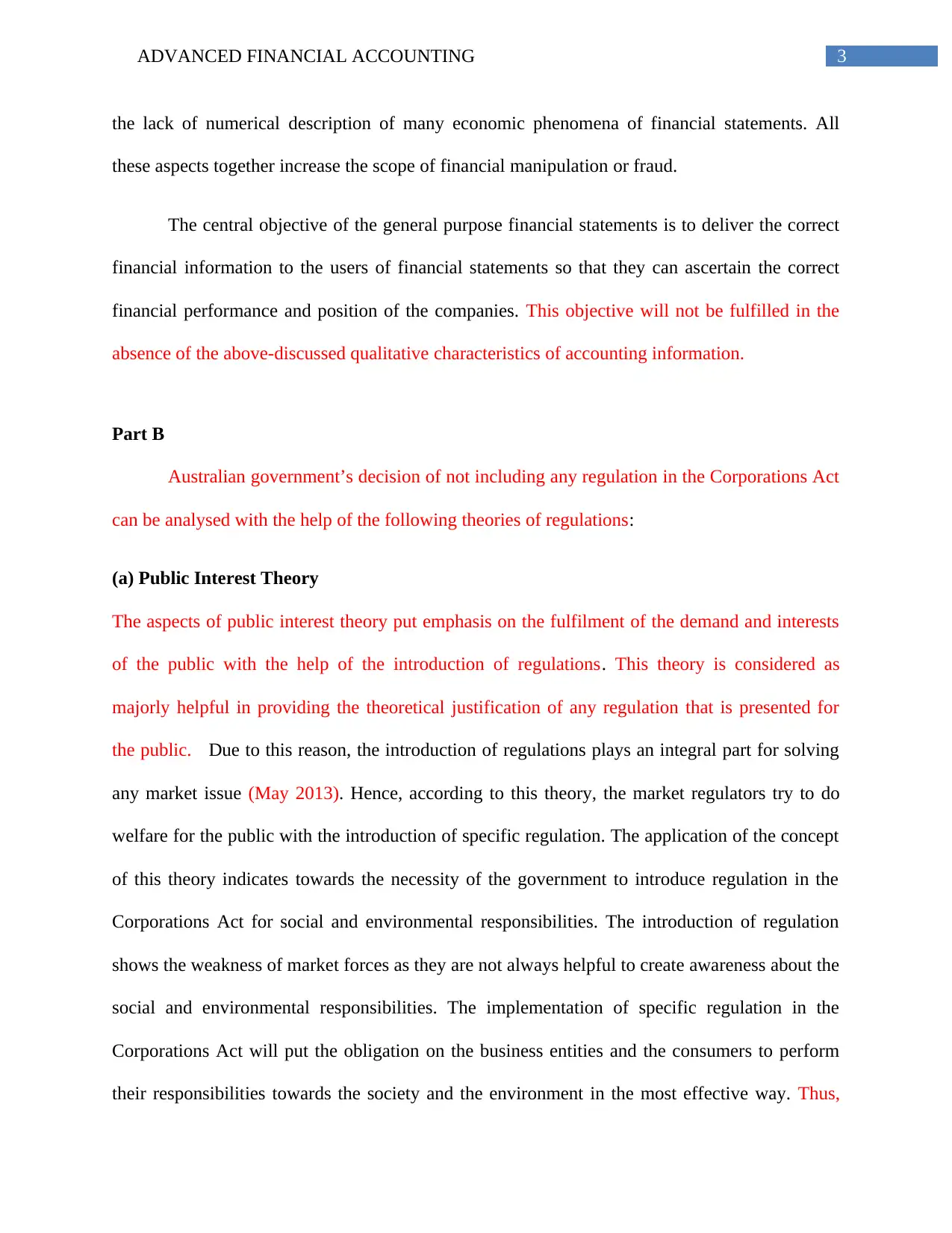
3ADVANCED FINANCIAL ACCOUNTING
the lack of numerical description of many economic phenomena of financial statements. All
these aspects together increase the scope of financial manipulation or fraud.
The central objective of the general purpose financial statements is to deliver the correct
financial information to the users of financial statements so that they can ascertain the correct
financial performance and position of the companies. This objective will not be fulfilled in the
absence of the above-discussed qualitative characteristics of accounting information.
Part B
Australian government’s decision of not including any regulation in the Corporations Act
can be analysed with the help of the following theories of regulations:
(a) Public Interest Theory
The aspects of public interest theory put emphasis on the fulfilment of the demand and interests
of the public with the help of the introduction of regulations. This theory is considered as
majorly helpful in providing the theoretical justification of any regulation that is presented for
the public. Due to this reason, the introduction of regulations plays an integral part for solving
any market issue (May 2013). Hence, according to this theory, the market regulators try to do
welfare for the public with the introduction of specific regulation. The application of the concept
of this theory indicates towards the necessity of the government to introduce regulation in the
Corporations Act for social and environmental responsibilities. The introduction of regulation
shows the weakness of market forces as they are not always helpful to create awareness about the
social and environmental responsibilities. The implementation of specific regulation in the
Corporations Act will put the obligation on the business entities and the consumers to perform
their responsibilities towards the society and the environment in the most effective way. Thus,
the lack of numerical description of many economic phenomena of financial statements. All
these aspects together increase the scope of financial manipulation or fraud.
The central objective of the general purpose financial statements is to deliver the correct
financial information to the users of financial statements so that they can ascertain the correct
financial performance and position of the companies. This objective will not be fulfilled in the
absence of the above-discussed qualitative characteristics of accounting information.
Part B
Australian government’s decision of not including any regulation in the Corporations Act
can be analysed with the help of the following theories of regulations:
(a) Public Interest Theory
The aspects of public interest theory put emphasis on the fulfilment of the demand and interests
of the public with the help of the introduction of regulations. This theory is considered as
majorly helpful in providing the theoretical justification of any regulation that is presented for
the public. Due to this reason, the introduction of regulations plays an integral part for solving
any market issue (May 2013). Hence, according to this theory, the market regulators try to do
welfare for the public with the introduction of specific regulation. The application of the concept
of this theory indicates towards the necessity of the government to introduce regulation in the
Corporations Act for social and environmental responsibilities. The introduction of regulation
shows the weakness of market forces as they are not always helpful to create awareness about the
social and environmental responsibilities. The implementation of specific regulation in the
Corporations Act will put the obligation on the business entities and the consumers to perform
their responsibilities towards the society and the environment in the most effective way. Thus,
Paraphrase This Document
Need a fresh take? Get an instant paraphrase of this document with our AI Paraphraser
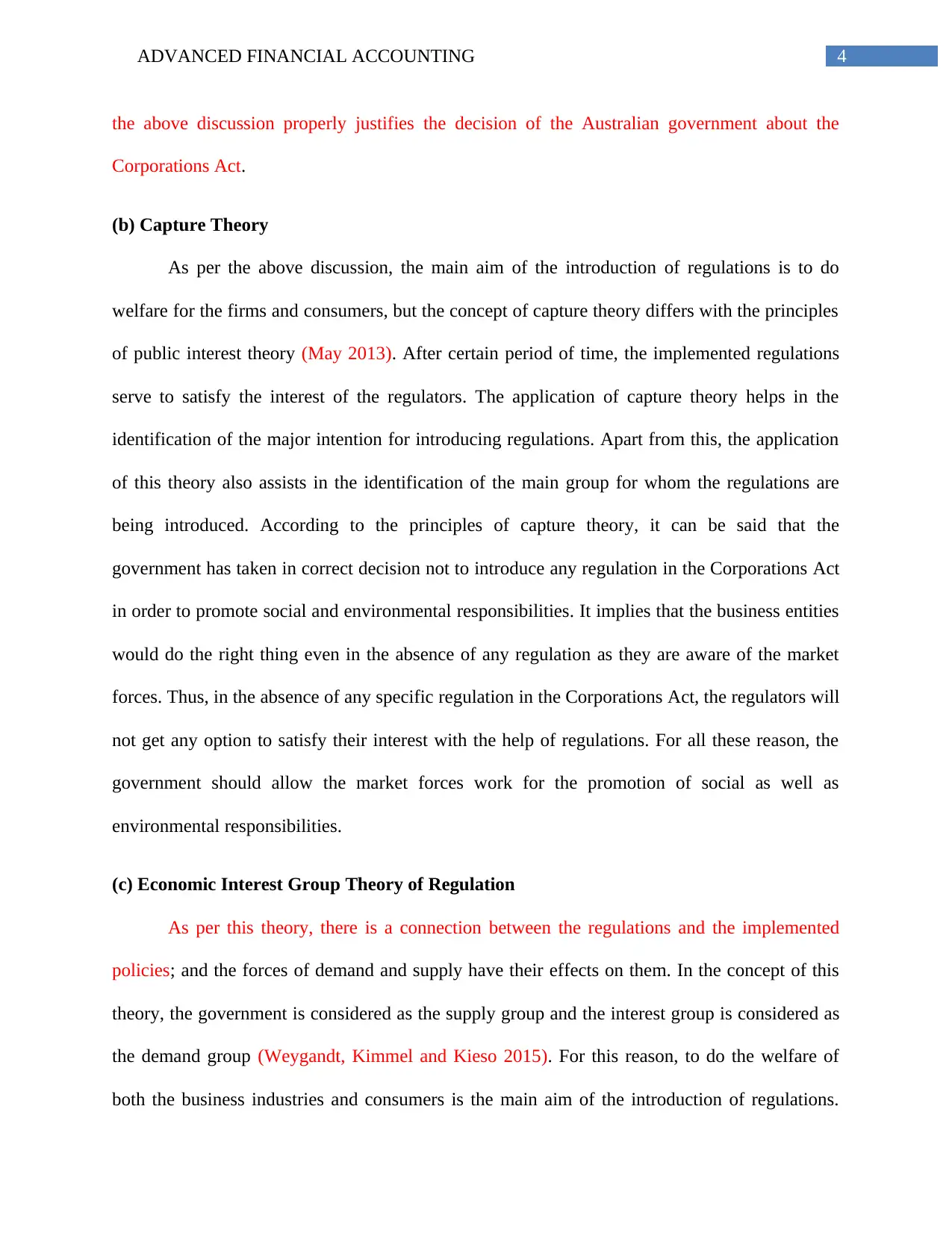
4ADVANCED FINANCIAL ACCOUNTING
the above discussion properly justifies the decision of the Australian government about the
Corporations Act.
(b) Capture Theory
As per the above discussion, the main aim of the introduction of regulations is to do
welfare for the firms and consumers, but the concept of capture theory differs with the principles
of public interest theory (May 2013). After certain period of time, the implemented regulations
serve to satisfy the interest of the regulators. The application of capture theory helps in the
identification of the major intention for introducing regulations. Apart from this, the application
of this theory also assists in the identification of the main group for whom the regulations are
being introduced. According to the principles of capture theory, it can be said that the
government has taken in correct decision not to introduce any regulation in the Corporations Act
in order to promote social and environmental responsibilities. It implies that the business entities
would do the right thing even in the absence of any regulation as they are aware of the market
forces. Thus, in the absence of any specific regulation in the Corporations Act, the regulators will
not get any option to satisfy their interest with the help of regulations. For all these reason, the
government should allow the market forces work for the promotion of social as well as
environmental responsibilities.
(c) Economic Interest Group Theory of Regulation
As per this theory, there is a connection between the regulations and the implemented
policies; and the forces of demand and supply have their effects on them. In the concept of this
theory, the government is considered as the supply group and the interest group is considered as
the demand group (Weygandt, Kimmel and Kieso 2015). For this reason, to do the welfare of
both the business industries and consumers is the main aim of the introduction of regulations.
the above discussion properly justifies the decision of the Australian government about the
Corporations Act.
(b) Capture Theory
As per the above discussion, the main aim of the introduction of regulations is to do
welfare for the firms and consumers, but the concept of capture theory differs with the principles
of public interest theory (May 2013). After certain period of time, the implemented regulations
serve to satisfy the interest of the regulators. The application of capture theory helps in the
identification of the major intention for introducing regulations. Apart from this, the application
of this theory also assists in the identification of the main group for whom the regulations are
being introduced. According to the principles of capture theory, it can be said that the
government has taken in correct decision not to introduce any regulation in the Corporations Act
in order to promote social and environmental responsibilities. It implies that the business entities
would do the right thing even in the absence of any regulation as they are aware of the market
forces. Thus, in the absence of any specific regulation in the Corporations Act, the regulators will
not get any option to satisfy their interest with the help of regulations. For all these reason, the
government should allow the market forces work for the promotion of social as well as
environmental responsibilities.
(c) Economic Interest Group Theory of Regulation
As per this theory, there is a connection between the regulations and the implemented
policies; and the forces of demand and supply have their effects on them. In the concept of this
theory, the government is considered as the supply group and the interest group is considered as
the demand group (Weygandt, Kimmel and Kieso 2015). For this reason, to do the welfare of
both the business industries and consumers is the main aim of the introduction of regulations.
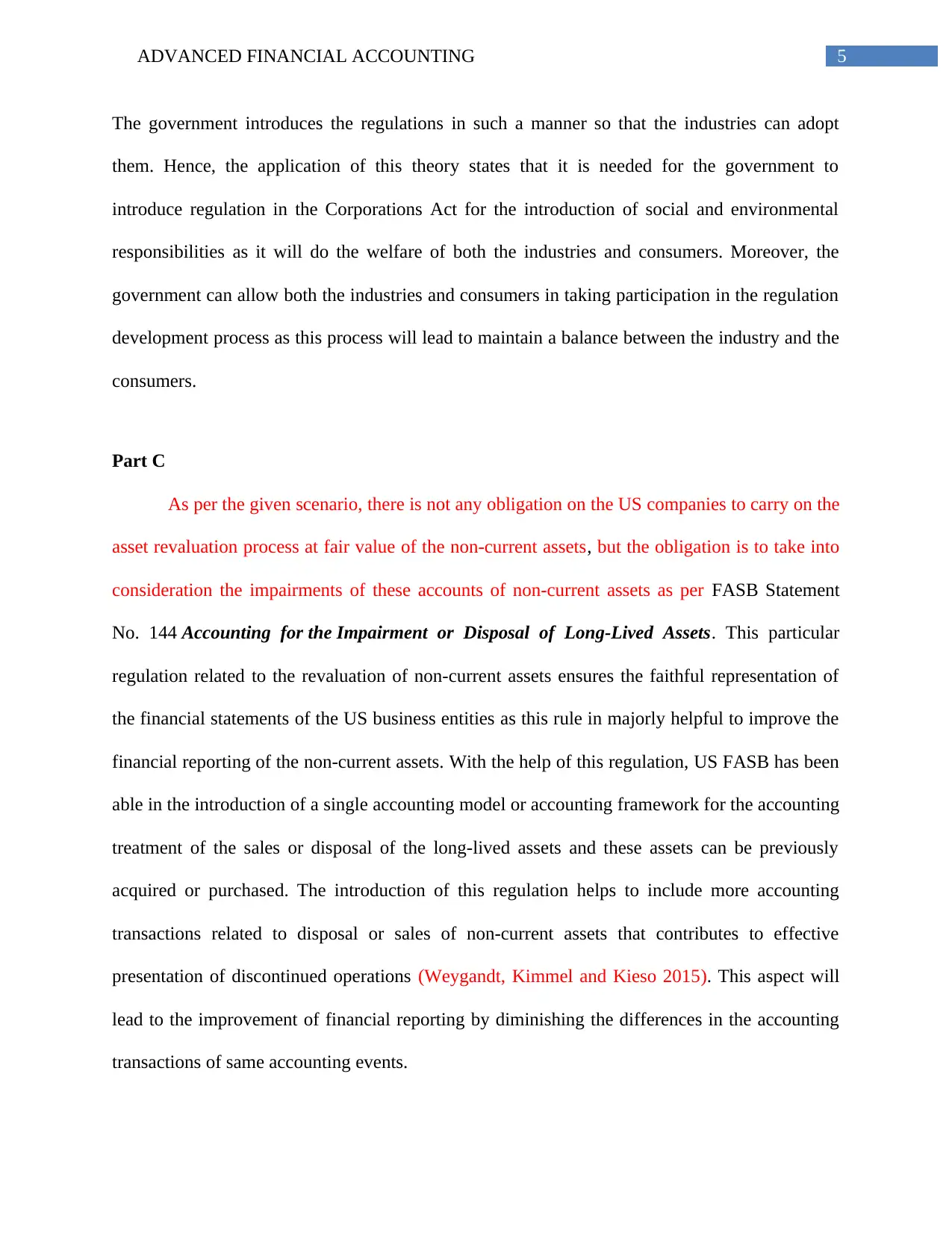
5ADVANCED FINANCIAL ACCOUNTING
The government introduces the regulations in such a manner so that the industries can adopt
them. Hence, the application of this theory states that it is needed for the government to
introduce regulation in the Corporations Act for the introduction of social and environmental
responsibilities as it will do the welfare of both the industries and consumers. Moreover, the
government can allow both the industries and consumers in taking participation in the regulation
development process as this process will lead to maintain a balance between the industry and the
consumers.
Part C
As per the given scenario, there is not any obligation on the US companies to carry on the
asset revaluation process at fair value of the non-current assets, but the obligation is to take into
consideration the impairments of these accounts of non-current assets as per FASB Statement
No. 144 Accounting for the Impairment or Disposal of Long-Lived Assets. This particular
regulation related to the revaluation of non-current assets ensures the faithful representation of
the financial statements of the US business entities as this rule in majorly helpful to improve the
financial reporting of the non-current assets. With the help of this regulation, US FASB has been
able in the introduction of a single accounting model or accounting framework for the accounting
treatment of the sales or disposal of the long-lived assets and these assets can be previously
acquired or purchased. The introduction of this regulation helps to include more accounting
transactions related to disposal or sales of non-current assets that contributes to effective
presentation of discontinued operations (Weygandt, Kimmel and Kieso 2015). This aspect will
lead to the improvement of financial reporting by diminishing the differences in the accounting
transactions of same accounting events.
The government introduces the regulations in such a manner so that the industries can adopt
them. Hence, the application of this theory states that it is needed for the government to
introduce regulation in the Corporations Act for the introduction of social and environmental
responsibilities as it will do the welfare of both the industries and consumers. Moreover, the
government can allow both the industries and consumers in taking participation in the regulation
development process as this process will lead to maintain a balance between the industry and the
consumers.
Part C
As per the given scenario, there is not any obligation on the US companies to carry on the
asset revaluation process at fair value of the non-current assets, but the obligation is to take into
consideration the impairments of these accounts of non-current assets as per FASB Statement
No. 144 Accounting for the Impairment or Disposal of Long-Lived Assets. This particular
regulation related to the revaluation of non-current assets ensures the faithful representation of
the financial statements of the US business entities as this rule in majorly helpful to improve the
financial reporting of the non-current assets. With the help of this regulation, US FASB has been
able in the introduction of a single accounting model or accounting framework for the accounting
treatment of the sales or disposal of the long-lived assets and these assets can be previously
acquired or purchased. The introduction of this regulation helps to include more accounting
transactions related to disposal or sales of non-current assets that contributes to effective
presentation of discontinued operations (Weygandt, Kimmel and Kieso 2015). This aspect will
lead to the improvement of financial reporting by diminishing the differences in the accounting
transactions of same accounting events.
⊘ This is a preview!⊘
Do you want full access?
Subscribe today to unlock all pages.

Trusted by 1+ million students worldwide
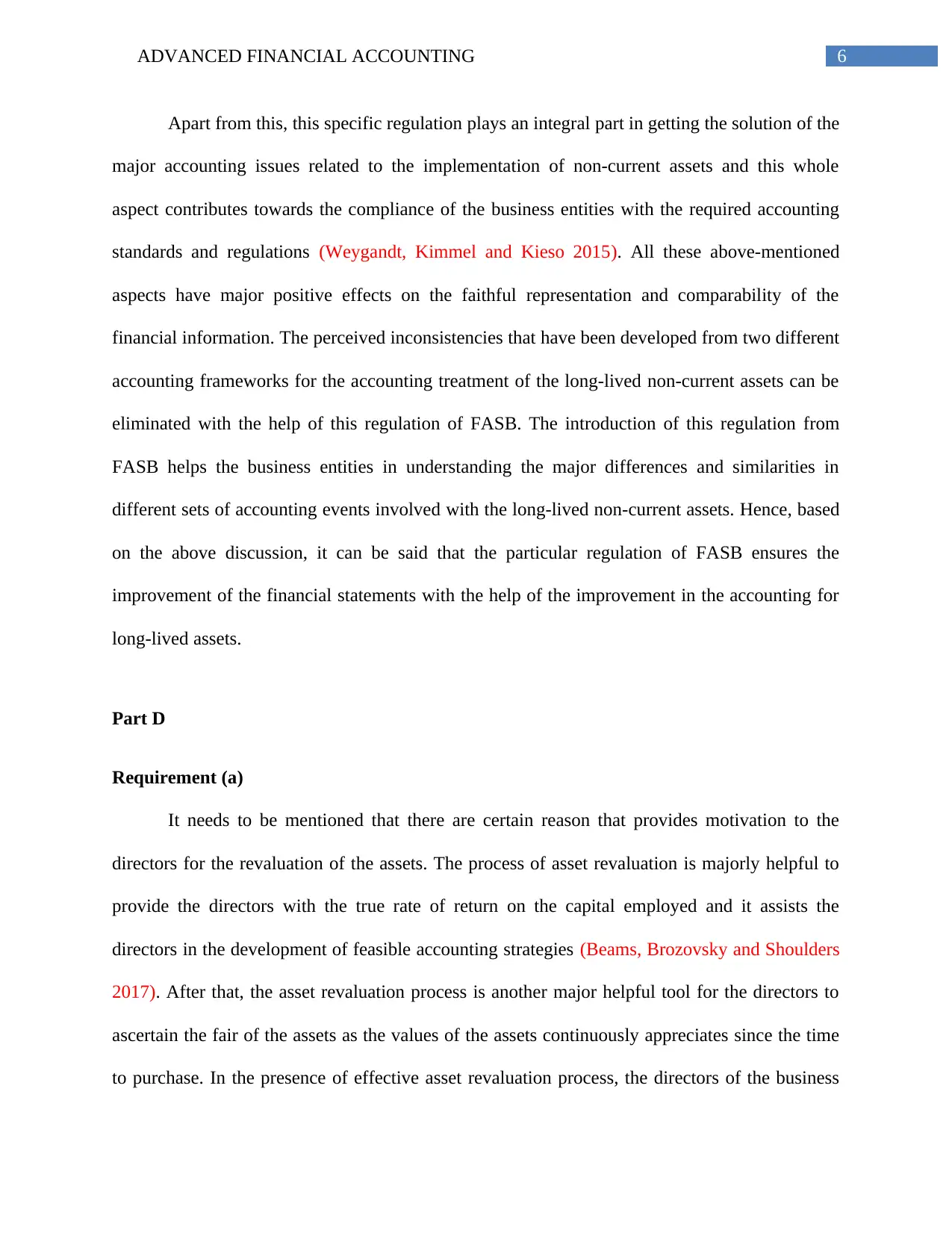
6ADVANCED FINANCIAL ACCOUNTING
Apart from this, this specific regulation plays an integral part in getting the solution of the
major accounting issues related to the implementation of non-current assets and this whole
aspect contributes towards the compliance of the business entities with the required accounting
standards and regulations (Weygandt, Kimmel and Kieso 2015). All these above-mentioned
aspects have major positive effects on the faithful representation and comparability of the
financial information. The perceived inconsistencies that have been developed from two different
accounting frameworks for the accounting treatment of the long-lived non-current assets can be
eliminated with the help of this regulation of FASB. The introduction of this regulation from
FASB helps the business entities in understanding the major differences and similarities in
different sets of accounting events involved with the long-lived non-current assets. Hence, based
on the above discussion, it can be said that the particular regulation of FASB ensures the
improvement of the financial statements with the help of the improvement in the accounting for
long-lived assets.
Part D
Requirement (a)
It needs to be mentioned that there are certain reason that provides motivation to the
directors for the revaluation of the assets. The process of asset revaluation is majorly helpful to
provide the directors with the true rate of return on the capital employed and it assists the
directors in the development of feasible accounting strategies (Beams, Brozovsky and Shoulders
2017). After that, the asset revaluation process is another major helpful tool for the directors to
ascertain the fair of the assets as the values of the assets continuously appreciates since the time
to purchase. In the presence of effective asset revaluation process, the directors of the business
Apart from this, this specific regulation plays an integral part in getting the solution of the
major accounting issues related to the implementation of non-current assets and this whole
aspect contributes towards the compliance of the business entities with the required accounting
standards and regulations (Weygandt, Kimmel and Kieso 2015). All these above-mentioned
aspects have major positive effects on the faithful representation and comparability of the
financial information. The perceived inconsistencies that have been developed from two different
accounting frameworks for the accounting treatment of the long-lived non-current assets can be
eliminated with the help of this regulation of FASB. The introduction of this regulation from
FASB helps the business entities in understanding the major differences and similarities in
different sets of accounting events involved with the long-lived non-current assets. Hence, based
on the above discussion, it can be said that the particular regulation of FASB ensures the
improvement of the financial statements with the help of the improvement in the accounting for
long-lived assets.
Part D
Requirement (a)
It needs to be mentioned that there are certain reason that provides motivation to the
directors for the revaluation of the assets. The process of asset revaluation is majorly helpful to
provide the directors with the true rate of return on the capital employed and it assists the
directors in the development of feasible accounting strategies (Beams, Brozovsky and Shoulders
2017). After that, the asset revaluation process is another major helpful tool for the directors to
ascertain the fair of the assets as the values of the assets continuously appreciates since the time
to purchase. In the presence of effective asset revaluation process, the directors of the business
Paraphrase This Document
Need a fresh take? Get an instant paraphrase of this document with our AI Paraphraser
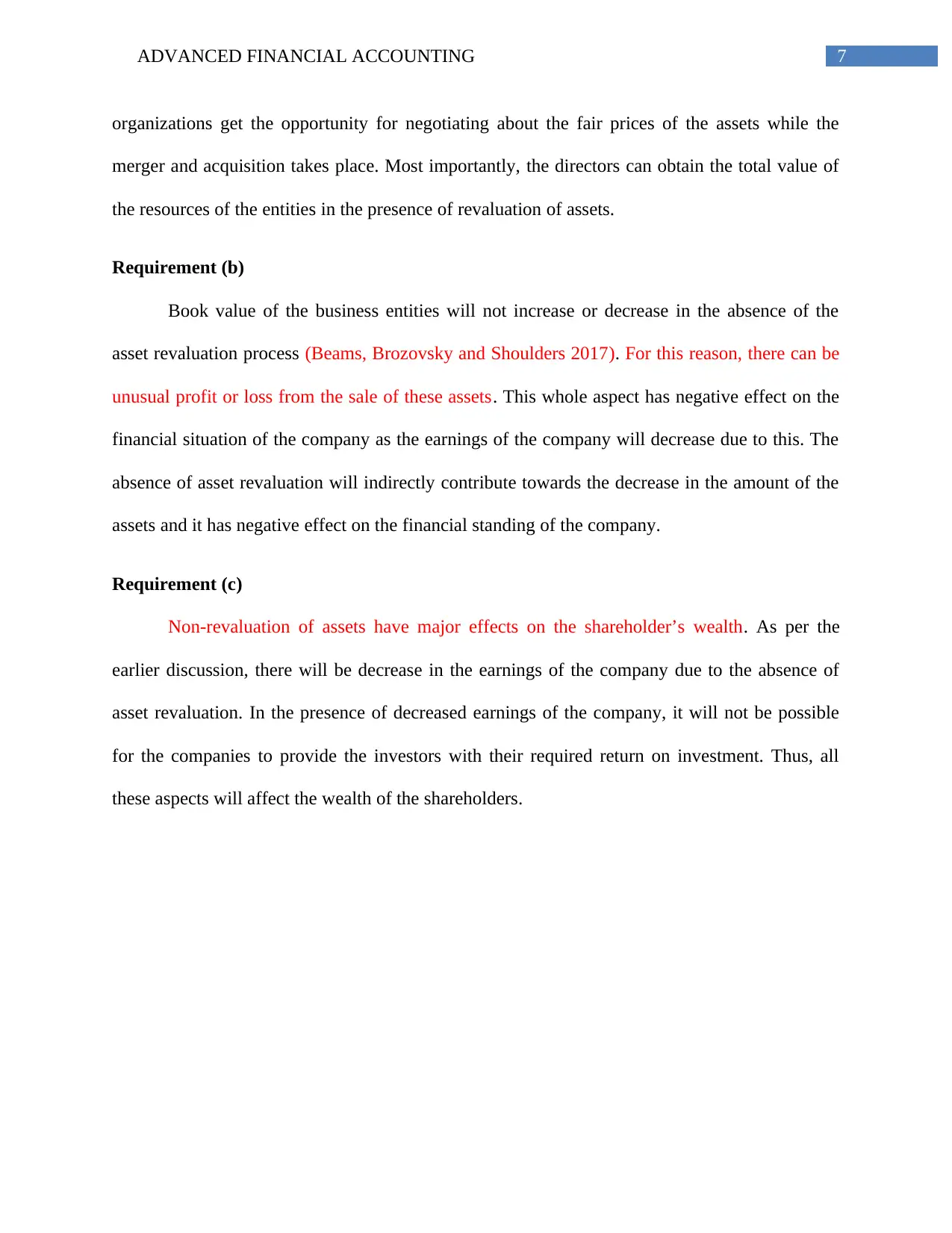
7ADVANCED FINANCIAL ACCOUNTING
organizations get the opportunity for negotiating about the fair prices of the assets while the
merger and acquisition takes place. Most importantly, the directors can obtain the total value of
the resources of the entities in the presence of revaluation of assets.
Requirement (b)
Book value of the business entities will not increase or decrease in the absence of the
asset revaluation process (Beams, Brozovsky and Shoulders 2017). For this reason, there can be
unusual profit or loss from the sale of these assets. This whole aspect has negative effect on the
financial situation of the company as the earnings of the company will decrease due to this. The
absence of asset revaluation will indirectly contribute towards the decrease in the amount of the
assets and it has negative effect on the financial standing of the company.
Requirement (c)
Non-revaluation of assets have major effects on the shareholder’s wealth. As per the
earlier discussion, there will be decrease in the earnings of the company due to the absence of
asset revaluation. In the presence of decreased earnings of the company, it will not be possible
for the companies to provide the investors with their required return on investment. Thus, all
these aspects will affect the wealth of the shareholders.
organizations get the opportunity for negotiating about the fair prices of the assets while the
merger and acquisition takes place. Most importantly, the directors can obtain the total value of
the resources of the entities in the presence of revaluation of assets.
Requirement (b)
Book value of the business entities will not increase or decrease in the absence of the
asset revaluation process (Beams, Brozovsky and Shoulders 2017). For this reason, there can be
unusual profit or loss from the sale of these assets. This whole aspect has negative effect on the
financial situation of the company as the earnings of the company will decrease due to this. The
absence of asset revaluation will indirectly contribute towards the decrease in the amount of the
assets and it has negative effect on the financial standing of the company.
Requirement (c)
Non-revaluation of assets have major effects on the shareholder’s wealth. As per the
earlier discussion, there will be decrease in the earnings of the company due to the absence of
asset revaluation. In the presence of decreased earnings of the company, it will not be possible
for the companies to provide the investors with their required return on investment. Thus, all
these aspects will affect the wealth of the shareholders.
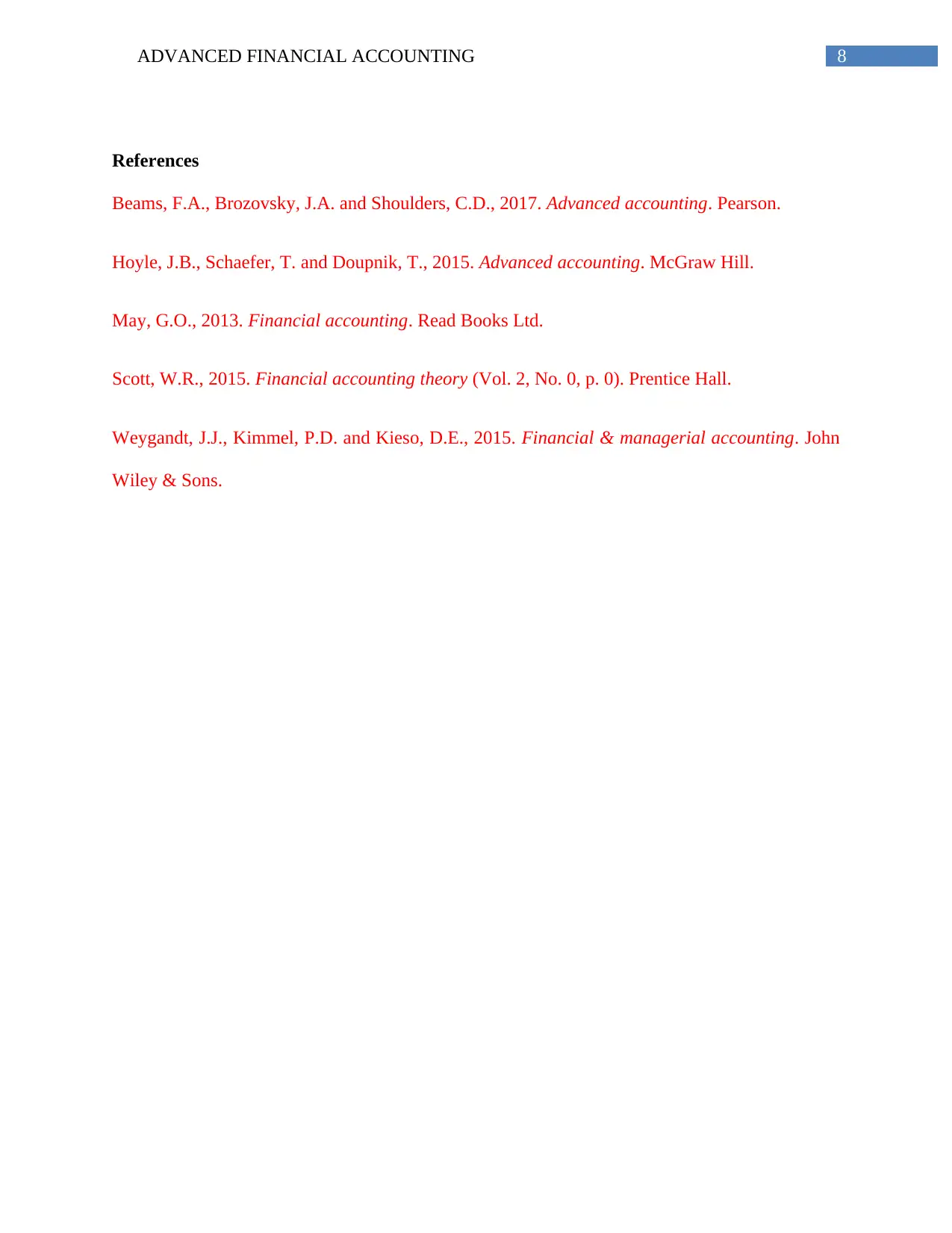
8ADVANCED FINANCIAL ACCOUNTING
References
Beams, F.A., Brozovsky, J.A. and Shoulders, C.D., 2017. Advanced accounting. Pearson.
Hoyle, J.B., Schaefer, T. and Doupnik, T., 2015. Advanced accounting. McGraw Hill.
May, G.O., 2013. Financial accounting. Read Books Ltd.
Scott, W.R., 2015. Financial accounting theory (Vol. 2, No. 0, p. 0). Prentice Hall.
Weygandt, J.J., Kimmel, P.D. and Kieso, D.E., 2015. Financial & managerial accounting. John
Wiley & Sons.
References
Beams, F.A., Brozovsky, J.A. and Shoulders, C.D., 2017. Advanced accounting. Pearson.
Hoyle, J.B., Schaefer, T. and Doupnik, T., 2015. Advanced accounting. McGraw Hill.
May, G.O., 2013. Financial accounting. Read Books Ltd.
Scott, W.R., 2015. Financial accounting theory (Vol. 2, No. 0, p. 0). Prentice Hall.
Weygandt, J.J., Kimmel, P.D. and Kieso, D.E., 2015. Financial & managerial accounting. John
Wiley & Sons.
⊘ This is a preview!⊘
Do you want full access?
Subscribe today to unlock all pages.

Trusted by 1+ million students worldwide
1 out of 9
Related Documents
Your All-in-One AI-Powered Toolkit for Academic Success.
+13062052269
info@desklib.com
Available 24*7 on WhatsApp / Email
![[object Object]](/_next/static/media/star-bottom.7253800d.svg)
Unlock your academic potential
Copyright © 2020–2025 A2Z Services. All Rights Reserved. Developed and managed by ZUCOL.





